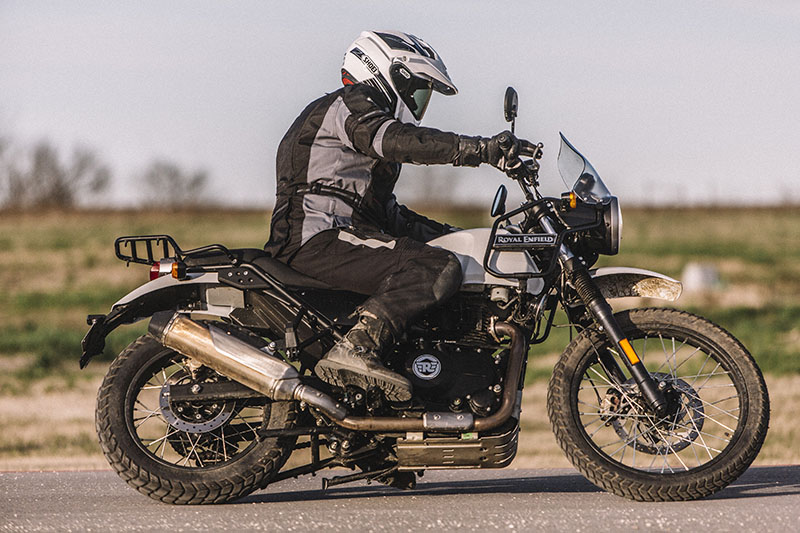
To understand the Royal Enfield Himalayan motorcycle, you need a little appreciation for the motorcycle market in India, where RE is based in Chennai. First, it’s ridiculously huge. More than a third of the country’s 1.3 billion inhabitants own a motorized two-wheeler, and the top-10 Indian motorcycle manufacturers bang out more than 1 million motorcycles per month. No horsepower wars there, though—of those million-plus, three-quarters are 150cc or smaller. Utility reigns supreme, and low cost, fuel efficiency and maneuverability sell far more bikes than power or luxury.
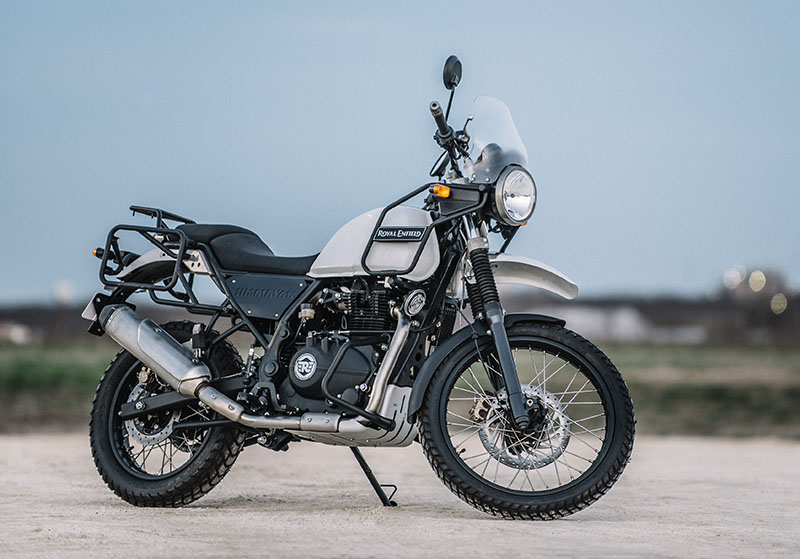
Outside of the hirsute commute in Indian cities, literally hundreds of tour groups—including Royal Enfield’s own Rides program—make adventurous treks by motorcycle up into the Himalayas in the far north and Nepal next door, braving treacherous dirt roads, extreme temperatures and passes at more than 18,000 feet because…well, because it’s there. In the U.S., Royal Enfield’s Bullet and Classic 500s are considered quirky retro machines and would never be used as dual-sports. In India though, perhaps because the brand has been around longest, or perhaps because its two-valve, air-cooled singles and stone-simple chassis and running gear are easily repaired roadside, Royal Enfield 350 and 500 singles are by far the most popular bike for slowly but surely clawing and scratching up into the mountains. They don’t go fast…they just go.
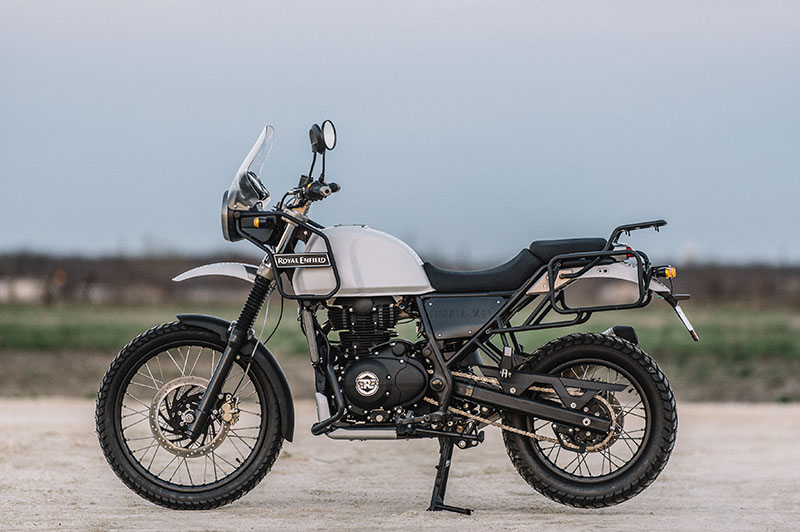
Once in danger of being sold off by its parent company Eicher Motors in the late ’90s, Royal Enfield is now on its way to becoming the world’s largest producer of middleweight motorcycles, growing 50 percent every year for the last six and opening new factories and technical development centers in India and the UK. In 2010 RE built and sold about 40,000 motorcycles; in 2018 that number will grow to at least 850,000. A pair of new 650 twins—the Interceptor and Continental GT—are coming to the U.S. lineup early next year, and RE says that more new engines and platforms will follow.
Read the Royal Enfield Story here
2018 Royal Enfield Continental GT and Interceptor | First Look Review
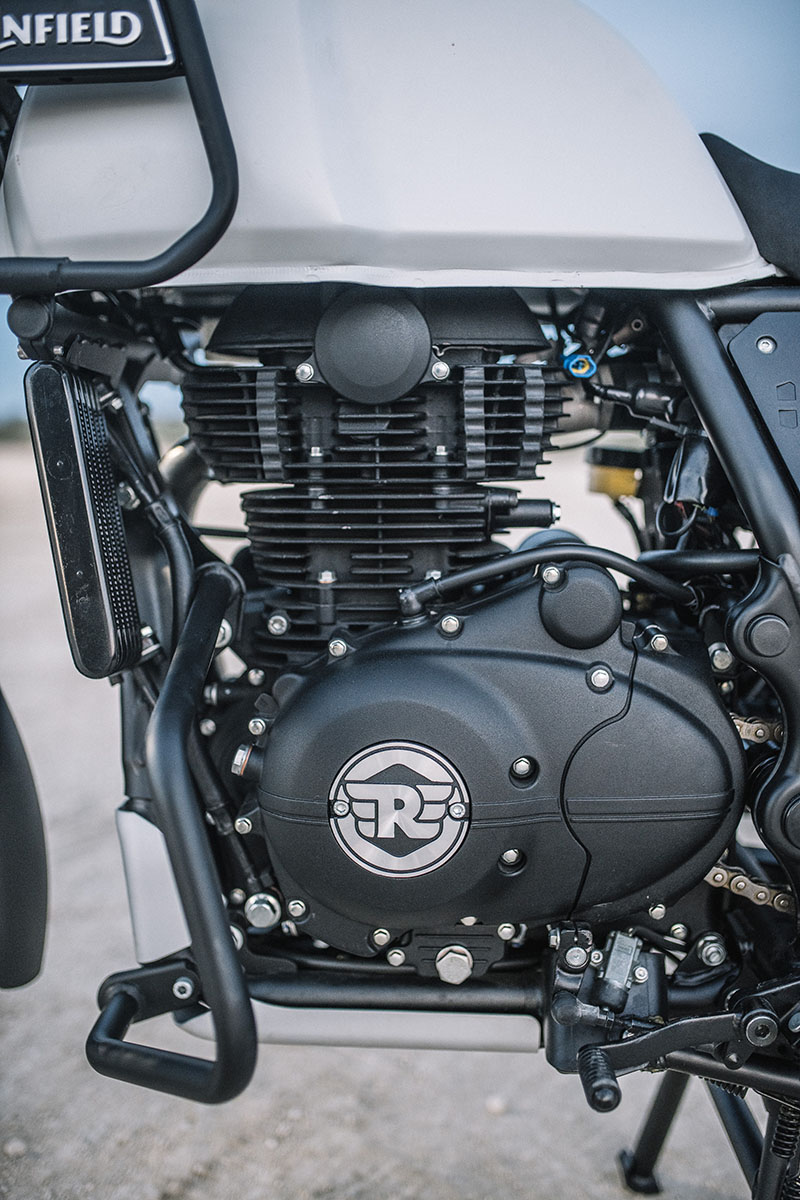
In that expansive environment, when some of the RE team noticed Bullet and Classic single owners modifying their bikes to better suit the rugged environment of the Himalayas, it was decided RE should build its own adventure bike, and the Himalayan was born. Originally designed just for India—with no pretense of competing with the likes of big, expensive ADV machines overseas—Royal Enfield North America (RENA) President Rod Copes nevertheless recognized the bike’s potential in our growing ADV bike market and convinced RE India to homologate the Himalayan for the U.S. Making the bike acceptable to our EPA and DOT with Keihin electronic fuel injection, different lighting and instruments, reflectors, etc., added a few pounds, but otherwise the compact bike is the same one taking riders over insane passes in the Himalayas like Rohtang and Thorong La.
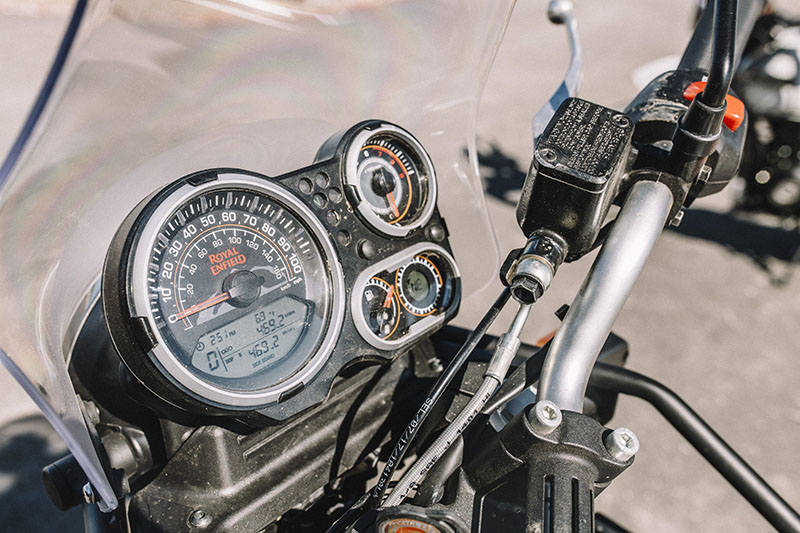
Even with these upgrades, the Himalayan is simple, fun and approachable, and its $4,499 price tag undercuts competition like the BMW G 310 GS (also made in India) and Kawasaki Versys-X 300 by as much as $1,200. With a claimed 24.5 horsepower at its redline of 6,500 rpm, the Himalayan’s SOHC, 2-valve 411cc single makes fewer ponies than those rev-happy bikes, but it was designed with a long stroke to crank out 26 lb-ft of torque, significantly more than the BMW or Kawi. This low-end grunt makes the 421-pound, fully gassed bike adept at climbing hills, churning up a rocky riverbed in a higher gear at low speed or squirting though traffic. Accessible screw-and-locknut valve adjusters simplify maintenance, and a gear-driven counterbalancer in the 5-speed LS 410 engine reduces vibes to just a mild pulse feel in the grips. Royal Enfield says its quality control issues of the past are under better control thanks to its new facilities in India, and because RENA makes a pre-delivery inspection of every bike at its PDI center in Texas before shipping them to dealers.
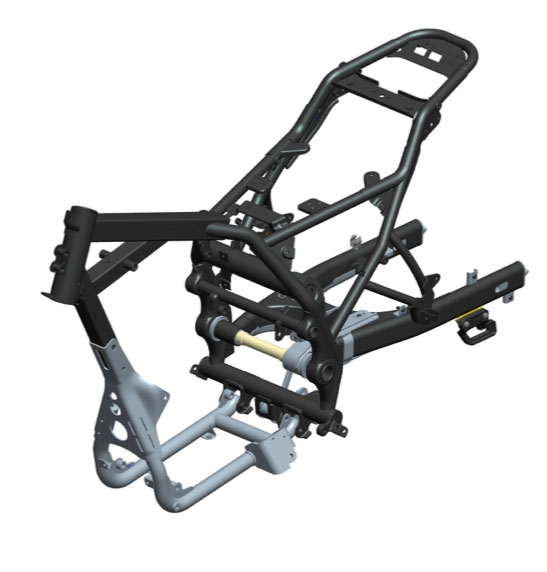
UK-based Harris Performance, which designs and manufactures road and racing motorcycle chassis and components (and was recently acquired by Eicher Motors), developed the Himalayan’s half-duplex split-cradle steel frame, Royal Enfield’s first with linked single-shock rear suspension. In addition to carrying luggage in back and a generous load capacity, major goals were to have both a low enough seat that the average Asian rider could plant both feet on the ground and plenty of suspension travel. Even with its relatively low 31.5-inch seat height—which feels much lower when you straddle the bike because of its narrow side panels—there’s still 7.9 inches of travel in front and 7.1 rear, and a generous 9 inches of ground clearance. Seating is upright and relaxed, with a high, wide handlebar and lowish footpegs that drag easily in turns but make standing up quick and easy. Larger riders will probably find the seat overly soft and seating a bit cramped on the smaller-scale ADV bike, but at 5-feet, 10-inches it fit me just fine.
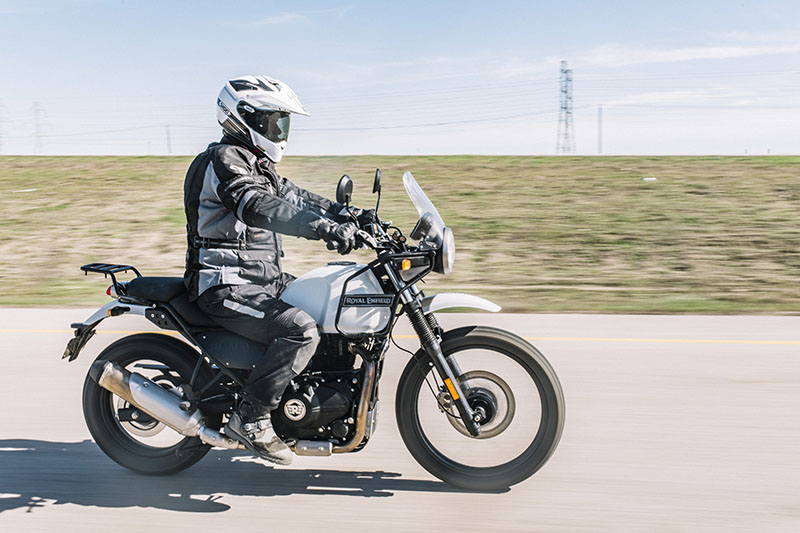
Royal Enfield launched the Himalayan in Midlothian, Texas, at TexPlex, a 1,000-plus-acre facility with lots of adult toys like earthmovers, jet boats and MX tracks as well as a large off-road riding circuit that was a good test of the Himalayan’s dirt capabilities. First we made a 1-hour on-road ride on back roads, winding through bucolic countryside past horse farms and barns. For 411cc the Himalayan holds it own well, with enough power to accelerate quickly into top gear on the Interstate and merge with traffic up to about 75 mph, where it runs out of steam. At lower speeds there’s just enough power to make quick passes and out-gun traffic—the bike feels very similar power-wise to a mid-1970s Honda XL350, in fact, but far smoother, and the EFI gives it good throttle response and a claimed 70 mpg, for a range from its 4-gallon tank of more than 250 miles. It would be a stretch to tackle our 80-plus mph Interstates in the U.S. for very long, especially in high-volume areas like Southern California, but the bike is OK for jumping on and off them and cruising saner highways and backroads.
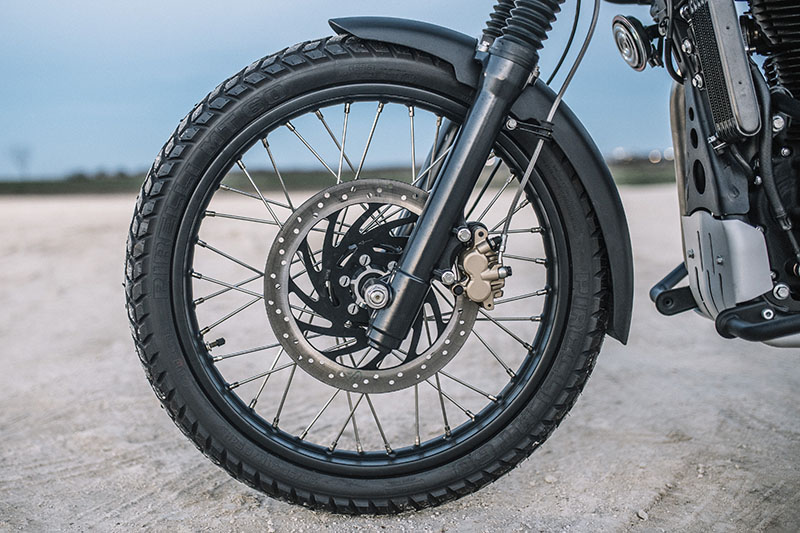
Suspension front and rear is made in India and is quite capable on-road and off, soaking up small bumps and big potholes without any drama and helping me ride the bike pretty quickly on the off-road course. Big G-outs would bottom the rear shock, but I couldn’t adjust the rear preload setting, which was only on the third of seven. Brakes are from ByBre, an Indian division of Brembo in Italy, and both the 300mm disc with 2-piston floating caliper up front and 240mm, 1-piston setup in back bite smoothly and strongly, with moderately high effort required in front typical of dual-sports. ABS is probably in our future since Europe and Australia already get it, but don’t look for traction control anytime soon. The Himalayan comes with excellent Pirelli MT 60 dual-sport tires that gripped both pavement and the near-perfect loamy soil (read: no sand) of the off-road course very well, and the 21-inch front wheel helps the bike roll over ruts and rocks and bite better in turns off-road. Overall this is a versatile, comfortable machine ready to take on mini adventures of any type or a short commute at street-legal speeds.
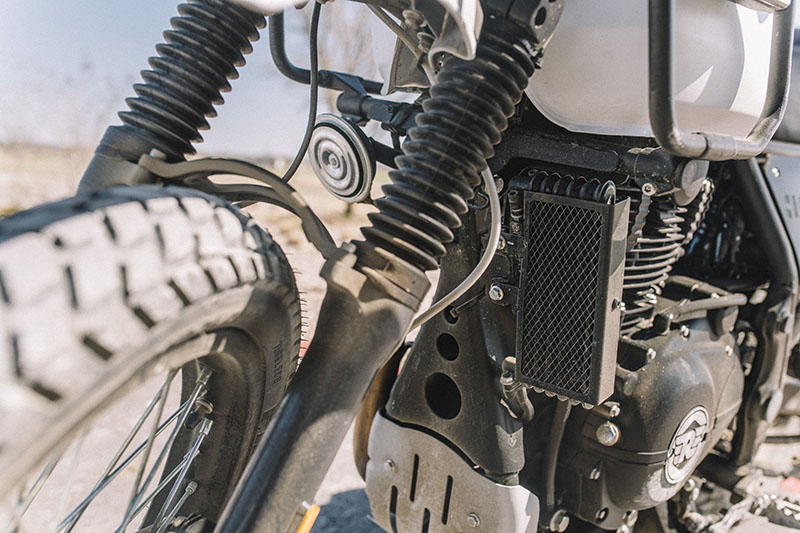
The bike’s sturdy frame is designed to support hard bags in back, and along with an aluminum pannier kit, Royal Enfield will offer an aluminum handlebar, bar-end weights and an engine guard as accessories for the Himalayan when it hits RE’s 75 dealers in April. There’s a small amount of storage underneath the locking seat, the steel tank will easily hold a magnetic tank bag and a luggage rack is standard. I do wish the brake and clutch levers were adjustable, and the bike lacks hand guards, though the Himalayan does come with a robust skidplate, centerstand and both high and low front fenders, the latter of which can be easily removed. That flyscreen does a great job of protecting the rider’s upper body, too, and enhances comfort over time. Royal Enfield definitely did its ADV bike homework in designing the Himalayan for long rugged rides…or should I say much of its homework was done for it by the thousands of riders who have conquered the Himalayas on its motorcycles, and will now do so on this one.
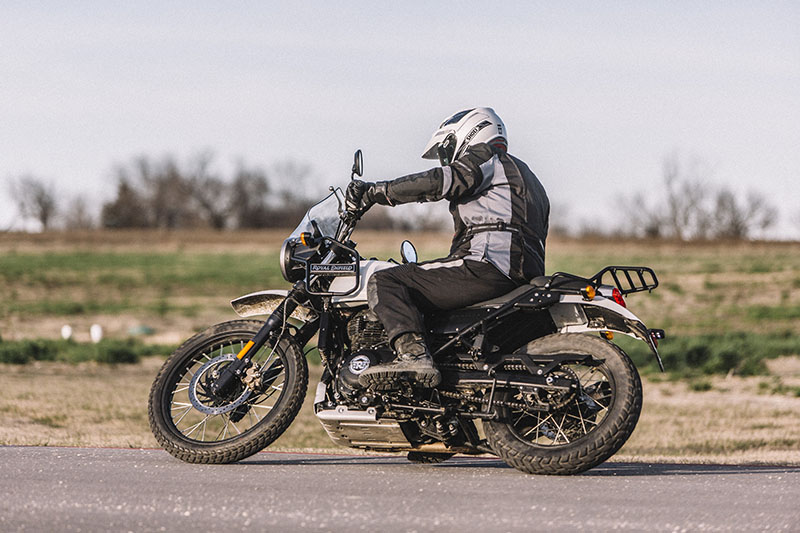
It’s easy to poke fun at this no-frills motorcycle as being too slow, too small or too low-tech for the American rider. But take a look at the typical megabucks Euro or Japanese ADV slathered with electronics the average rider will never use or understand, that is often too tall and too heavy for him/her to ride off-road, never mind pick up, and the Himalayan starts to make a lot of sense. While you may not get there very fast, you are going to get there….
Rider’s Guide to New/Updated Street Motorcycles for 2018
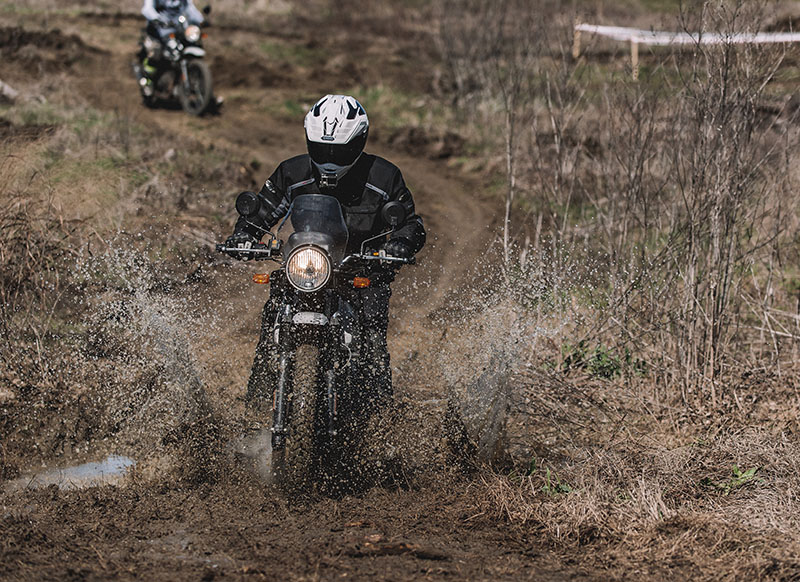
Mark’s Gear
Helmet: Shoei Hornet X2
Jacket: Joe Rocket Ballistic Adventure
Pants: Rev’It
Boots: Sidi Canyon Gore-Tex
2018 Royal Enfield Himalayan Specs
Website: royalenfield.com/USA
Base Price: $4,499
Engine Type: Air-cooled, SOHC single, 2 valves
Bore x Stroke: 78.0mm x 86.0mm
Displacement: 411cc
Transmission: 5-speed, cable-actuated wet clutch
Final Drive: O-ring chain
Wheelbase: 58.0 in.
Rake/Trail: 26.5 degrees/4.3 in.
Seat Height: 31.5 in.
Claimed Wet Weight: 421 lbs.
Fuel Capacity: 4.0 gals.
MPG: 86 octane min (high/avg/low) NA








I just can’t wrap my head around purchasing a RE on economic grounds. After all, anyone can buy a well maintained V-Strom or Versys or any number of similar bikes for the same amount of money. For my money, access to parts and service make the case for midsize lightly used Japanese “adventure” bikes. I’d have zero reluctance to buy a well maintained (farkled) V-Strom that has 40 000 miles on the odo. Because I don’t know what they’d be, I’d love to hear arguments contrary to this position.
The V-strom doesn’t really have the ground clearance, the underside protection, or the luggage capacity to do what this bike can do.
This bike is made for tough slogs packed like a mule.
Try that with a Vstrom and you’ll smash headpipes, puncture your oil filter, and end up walking home.
As Greg stated, those are Sport Touring bikes, not ADV/Dual Sport bikes. If you’re going to compare the Himalayan to anything, let it be the KLR 650.
And sure, you can buy a used bike for less – isn’t that the case with literally ANY motorcycle though? I purchased a Himalayan back in July over a used KLR 650, DRZ 650 and a few others – because my OTD price ended up being barely higher than the aforementioned pre-owned bikes, and the Himalayan was a virgin canvas for me to build and setup to my personal liking.
I’ve since thrashed it on well over a thousand miles of technical trails (trails that a Versys or V-Strom would never begin to make it up mind you) and over 5000 miles of highways. The bike happily cruises at 65-70mph all day which for our 65mph interstates in CA is more than sufficient. Without my hard cases attached, I average 72-74mpg, and with them attached I go “down” to 62mpg; Both numbers are superior to anything else I could have gotten – pre-owned or otherwise – that would have given me the capability I currently have for my budget.
The Himalayan is a simple, easy to wrench on, utility bike. It’s what motorcycle’s used to be – a motorcycle for the sake of being a motorcycle. The closing line of this article is something I tell everyone when they ask me about the bike. You won’t win any races with the Himalayan, but you can bet your ass it’ll get you there. The latter is something that can’t be said of most bikes, even ones that cost 2 or 3 times as much.
To own an REH you have to have the mindset of who it was designed for, if you haven’t, no amount of explaining will change that. I bought a 2018 BS4 over the phone. Being an older rider who’s more interested in taking the road less travelled, we’re philosophically connected. Easy to service, you’ll quickly to develop a relationship with your dependable little mule.. gets great mileage and is very user friendly. It’s unique!
Buying a good used bike is complex because you are never sure of what you are getting.
Motorcycles live hard lives as they are run hard and sit unused a lot.
My best advice is to buy one with obvious fault that you can fix.
Mileage is obvious but not cheaply easily repaired. I’d suggest buying something with less than 20,000 miles so you can get some use of it.
In general:
New is better than used.
Simple is better than complex
Japanese bikes are hard to beat
Walter – here you go:
Seat heights
– V-strom 650 – 32.8
– V-strom 1000 – 33.5
– Versys – 33.3
Me – short inseam … therefore those are bikes I won’t even consider.
Royal Enfield – 31.5 inches … now I’m in the market.
Bingo. That applies to lots of us.
This bike has a cool story behind it, but I don’t understand where fuel injection fits into “simple”. I have a KLR 650 and a Super Tenere both purchased new and both with over 30k on the clock. The carbed KLR always makes it home, but the injected Tenere has taken truck rides to repair stations several times (error codes, failed fuel pump relays, ecu problems, factory reflash etc.) Both good bikes, but if you really are going off the path, leave as much of the electrical junk out of the mix as possible. New (left over) KLRs can be had all day long for under $5500, lots of dealers, huge after market, huge community etc. I like the Himalaya a lot, but for me, it’s an answer to a question I didn’t ask. Having said that, I can’t wait to see one in the flesh!
It is becoming less and less possible for single piston engines to pass EPA tests while equipped with carbs.
I suspect the small RE engine could not, but with EFI it can.
True mate. It has carb version in India.
The only time I’ve seen EFI fail was when a Honda CBR 300 sat in a garage for 2 years with the same gas. Other then that I’ve never seen nor do I know of anyone who has had EFI system fail. On the other hand I do know a heck of a lot of people who had carbs fail. Point in case you may have efi fail though unlikely but your carbs will fail.
While you’re cleaning out your clogged carb from the bike sitting all winter, I’ll be out riding my fuel-injected bike.
Bike looks good, love the profile. The price of the luggage seems high compared to the price of the bike. Just don’t believe the bike would stay together, reminds me of an AMF Harley. You would never get lost, just follow the trail of fallen off parts. The new 650 twin looks pretty good too, again with nice profile. But I hardly see any RE’s on the road, and the 500’s I’ve seen at the dealer had lousy paint + chrome and just looked cheap when you got up close. Rider should get the ADV 400 + the 650 twin as long termers and see if they hold up to everyday use and then report the findings to its readers.
I got my deposit on one, why? Not the price! 9” ground clearance, 21” front tire, no ABS, no traction control, air oil cooled, and most importantly 31.5 seat height! Yes I would have liked a carb instead of EFI, no thanks to EPA.
Hi Tim. You ordered #1, I got #2. See yo at thev Western States 1`000!
Who needs clean air? Long live obsolete technology . . .
Good article and excellent comments. I am in the market in Canada and I have narrowed it down to Kawi
KLX 250 new with EFI, or Honda CRF 250L used. Always good to have more competition. Better for the class
and I will keep an open mind. I am old enough to remember when Japanese bikes were “suspect”. I am
never an early adopter, but choices are always good for the consumer. Cam
What I wanna know is – How does Greg D. feel about this bike? I’m a string bean, but a 6 footer. If Greg is comfortable enough on it, I’d strongly consider this for myself….
I understand that this bike was first intended for India market but it’s too big by just 12 cc to be a candidate for the sub 400cc plating categories here in Canada QC . Lower registation tarif occurs when the bike get no more than 399cc in my province .
Same in BC. I would buy a new one otherwise. But insurance will cost way more than a sub-400cc bike, so it’s not worth it here either.
I bought my 2018 RE Himalayan a few days ago. For me, age 69 and a 28” inseam, it is something I feel enjoy for leisurely day trips. The weight is light enough for me to handle. I don’t need a loaded Harley or a high-seat BMW or other big-ticket item. The price is attractive, but it was not the main reason. Simple is better for me. I have an analog, retro brain, it appears. A dealer is near me in Greensboro, North Carolina, so I can rely on them. I hope RE catches on !
I have 400 miles on my Himilayan in Reno Nevada. Great light street bike for short commutes. Not a dirt bike. Too heavy, especially in front. My freind bought one and we love them so far. Great for riding forest and desert hard pack roads. Terrible in soft stuff and climbing big steep dirt hills. Dont compare or expect off road performance like 2stroke 250 yz. That said it cruises 25-40 mph on graded roads with ease, and all day 50-75 on pavement. Smooth and gets great milage. Overall im happy even after dumping it three times in soft stuff. Gonna get bark busters, engine, and bag guards. After warranty is up i will look into any engine mods that are reasonable like exhaust/chips? But its so quite. Who needs all that noise. And everywhere i go people are curious and asking about them. The white model looks great. Hope they do other colors. RE has a real winner here and the other manufactures are taking notice. The dealer sold 4 of these on the day i bought mine.
how about commute it everyday for work on jam-packed roads at peak hours in the city? is it nimble and maneuverable to go around cars?
As is par for the course, manufacturers always seem to come close but never right there when it comes to new models. I’ve ridden the 400 and like ‘a lot’ of it. However at 6-2 and heavier than I want to be the bike feels a tad small. It is smooth as silk and adequate on the road but why do I walk away wondering why it feels a lot like an old Honda XT250? In todays techno standards a 400cc bike that puts out less power than most equivalent 250’s is deflating. Couple that with the recently released RE 650 Interceptor and all I can think about now is can I squeeze that 6 speed twin into the Himalayan frame? I often time wonder exactly who is doing the research for bike manufacturers? No ones ever asked my opinion.
The RE Himalayan is an affordable user friendly package. They have given you what you need to make a great dual purpose bike. If you want to race, buy a race bike. Mild power means it isn’t digesting itself and sucking down massive amounts of fuel. 2 Valves keep maintenance low and doable for the home mechanic. A center stand means you don’t have to throw your machine on its side in the dirt when flat-repair time comes; this is a serious feature for the practical user. This bike has a lot of built in features to make a long ride achievable; they have paid attention to what works. Well done R.E.!
Picked my 2019 Himalayan last week. I was looking for another bike to explore all the gravel roads and one lane farm roads near me and seat comfort was a main consideration. The dual sports/adventure bikes I have had are ’93 Honda XR250L, ’01 DRZ400S, ’08 KLR 650, ’11 Versys 650, and ’12 KLX250S. Wish I still had the ’93 XR250L. That was the last dual sport made with a low seat height and fairly comfortable seat. Seat comfort, simplicity, and looks is what made me choose the Himalayan. Very little plastic. Doesn’t look like it was designed to resemble a praying mantis like so many adventure bikes. No pretense of being a high performance machine. Just a comfortable, affordable, ride to enjoy. No radiator to fail and overheat the engine.